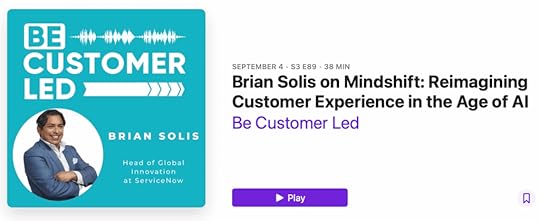Brian Solis's Blog, page 3
October 2, 2025
Brian Solis to Explore How CEOs Should Navigate AI To Build the Organization of the Future, Today
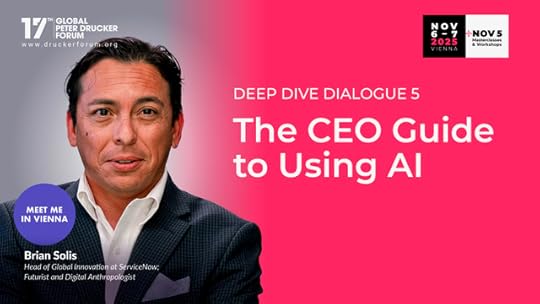
Brian Solis is beyond excited to represent ServiceNow on stage at the prestigious Global Peter Drucker Forum.
The theme for this year is, “Leadership: All Hands on Deck.” It’s indeed the moment to retire the “business as usual” playbook and start thinking AI-Forward.
He will participate in an exclusive conversation with Johan Roos to explore the new C-Suite and the future of leadership.
Please join him and an entire cast of some of the most innovative, academic, and creative thinkers!
Program DescriptionThe CEO Guide to Using AIHow can senior executives capitalize on emerging AI tools to do their own work better? And how necessary will that become to their effectiveness and abilities to lead?
Chair
Johan Roos Executive Director, Vienna Center for Management Innovation (VCMI); Presidential Advisor Hult Int. Business School
in conversation with
Brian Solis Head of Global Innovation at ServiceNow; Futurist and Digital Anthropologist
Please visit the event site here to learn more and register.
The post Brian Solis to Explore How CEOs Should Navigate AI To Build the Organization of the Future, Today appeared first on Brian Solis.
October 1, 2025
Brian Solis to Present at MetLife’s Triangle TechX (TTX) Event
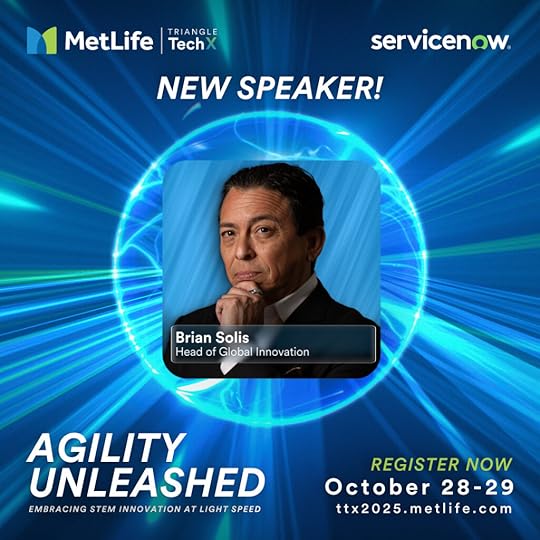
Metlife just announced that Brian Solis will present on AI business model innovation at Triangle TechX (TTX).
The theme for this year’s event is “Agility Unleashed: Embracing STEM Innovation at Light Speed.”
Registration is free! Please sign-up here. Live and virtual opportunities are available!
The post Brian Solis to Present at MetLife’s Triangle TechX (TTX) Event appeared first on Brian Solis.
September 30, 2025
Hunter S. Thompson’s Lesson for Executives Determined to Automate Their Workforce

I was thinking about the Accenture and Walmart news on AI and jobs. It reminded me of a letter Hunter S. Thompson wrote a friend reminding him the importance of purpose in our work.
For power users, people are starting to “sound” like AI IRL and studies find that we’re losing our creativity and critical thinking the more we transfer brain power to gen AI.
We must have purpose in AI transformation and how we work with AI and agents. We cannot lose sight of human potential as we automate work. We must not lose the human in how we design work toward outcomes. We must make the outcomes, meaningful, to the business, and the recipients and beneficiaries of those outcomes. Otherwise, our work and unique value starts to become the next em dash.
“…we must make the goal conform to the individual, rather than make the individual conform to the goal. In every man, heredity and environment have combined to produce a creature of certain abilities and desires— including a deeply ingrained need to function in such a way that his life will be MEANINGFUL. A man has to BE something; he has to matter.”
There is something to be said about those who minimize work and those that maximize outputs and experiences to the beneficiaries of them. This video is a barometer for executives to decide on which side of transformation they want to be measured.
As humans, we sometimes, may too often, like to hit the easy button. But it’s short term gains over long term viability. We compete for the moment and not the future. Ironically, our fate isn’t just in the hands of AI and how leaders see the future of an AI workforce, but also how we shape our own destinies. Research already shows that we may already offload too much of our thinking and communication skills to AI vs. collaborating with it to do what was previously impossible.
In 2022, Airbnb was considering massive layoffs due to a sharp drop in bookings. Serving as a personal mentor to CEO Brian Chesky, Apple’s Jony Ive shared a long-term perspective as he weighed the cuts.
“You aren’t going to cut your way to innovation,” he told Chesky.
The same is true with AI business transformation.
In the end, you can’t automate your way to innovation. 
If all you do is aim to scale what you did yesterday, you miss the opportunity for people and AI to collaborate toward achieving what was impossible yesterday, unlocking net new value creation and growth. The smart move is to balance both paths.
The post Hunter S. Thompson’s Lesson for Executives Determined to Automate Their Workforce appeared first on Brian Solis.
September 18, 2025
Igniting AI Transformation: How to Future-Proof Your Company in the Age of AI

Technology moves at its own pace, adoption moves at the pace of culture.
I joined Deloitte’s AI Ignition podcast with Beena Ammanath, Executive Director, Deloitte Global AI Institute, to talk about why AI feels different from past waves of technology, what it asks of leaders, and how we can turn disruption into a competitive advantage.
Beena opened by reminding us of a simple truth from Deloitte’s research: “technology moves at its own pace, but the adoption of the technology in an organization moves at the pace of the organization’s culture.” That became the backbone of our conversation.
Please watch/listen here .
Why AI Feels Different (and What to Do About It)AI triggers something deeper than the usual automation cycle.
After watching the “Godfather of AI” Geoffrey Hinton’s sobering exchange with Steve Bartlett on Diary of a CEO about the future of jobs and humanity, I had to pause and think about our next steps. His vision for the future of work wasn’t, let’s just say, cheerful or terribly motivating. But fear without agency is paralyzing. It’s easy to spiral into dystopia. I believe the better move, however, is to treat those scenarios as inputs for planning, to reverse engineer those potential scenarios to help people take steps to reshape their future and the future of work, now.
Leaders and employees are still figuring out how to collaborate with AI. Most organizations are trying small automations or pilots, but “very few are reimagining what their future organization… can look like in partnership with artificial intelligence.”
That’s the work. We can shape what comes next.
I accept that there’s a lot to learn and a whole lot to unlearn moving forward.
Transformation begins with a mindshift.
To have that mindshift is to give yourself the gift of learning and unlearning, to see what you couldn’t see before, to do what you couldn’t do before.
We are all tempted to manage the future with the logic of the past. That only produces iteration. AI deserves, and requires, innovation, the pursuit of creating new value.
Beena underscored the same point from Deloitte’s research: technology moves at its own pace, but adoption moves at the pace of culture and change. If we do not evolve how we think and work, the technology cannot deliver its promise.
Begin with a Motivational Future StateBefore roadmaps, start with vision. I shared how storied entrepreneur and venture capitalist Vinod Khosla’s provocation, “there’s only 200 people in the world that understand what’s really happening right now,” pushed me to go deeper.
Your job is to make that 201 inside your own company.
Start by defining a motivational future state: an inclusive and inspiring vision where you want to be in 18–24 months with AI and how you’ll know you’re on track along the way. The goal is to make that vision tangible and aspirational, one where people see themselves in it and believe they play a role in bringing that vision to life. Then reverse-engineer the steps and the measures (OKRs/KPIs) people can align to, and get to work.
This demands a mindshift:
“To transform your thinking and your organization, you have to start by disrupting yourself.”
It means unlearning patterns that default to incrementalism. Otherwise we “limit our opportunities and our outcomes to iteration and not innovation.”
Culture Is the CatalystI’ve spent years in transformation work. After studying waves of innovation, digital transformation and now AI business transformation, consistently, I found that the biggest catalyst andinhibitor in driving change is culture. Beyond vision and mission statements, behind earnings calls and publicity, people need to see themselves in the story and as part of story from beginning to end. They have to believe they have agency in the outcome, and share a vision, incentives, and motivation, with leaders and teams across the organization.
Measure What Matters“If you can’t articulate what the future looks like… then you can’t have a culture that brings that AI transformation to life.”
Execution turns vision into velocity.
Beena pressed on execution. My answer: break the portfolio into three lanes in parallel, not sequentially. This was inspired by Gartner research:
Quick Wins to build confidence and momentum.Differentiated Use Cases that create advantages (not just an “AI-powered status quo”).Transformational Bets that alter trajectory.If you can’t describe the vision and measures for each lane, you’re not ready to execute.
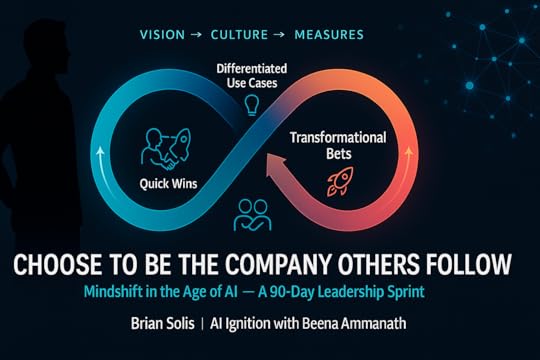
Anxiety persists because people don’t see where they fit. So we cannot leave the workforce behind.
Build on the vision, then audit your workforce against your articulated future motivating state: which capabilities are missing, where do you excel, what can AI agents do today and tomorrow, what requires human orchestration, and how success will be measured?
Don’t tell people to “use AI for deeper work” without defining what deeper work is, how to get the skills, and how it will be recognized.
“What we can do is start to get some tangible elements…then look at the workforce and audit it…what are the jobs we need, what are the skills we need, how are we going to get people there, and how are we going to balance them with AI and train them to be able to execute?”
Fear and uncertainty recede when people know what success looks like and how they will be supported to get there.
Align Progress Against an AI Maturity IndexWe also discussed industry patterns. From our latest ServiceNow AI Index, we saw AI maturity regress year over year by nine points. This was a huge finding in that, on average, companies scored 35 out of a possible 100 (with 100 being the most mature). Last year, the average score was 44.
We learned that this year, companies expressed that AI was moving too fast. In just the last three years, we’ve experienced the overnight rise of generative AI, then AI agents, and now the agentic enterprise. Organizations struggle with the speed of change and the governance necessary to safely and effectively pilot and scale.
Even so, I’m seeing bold pilots in manufacturing (robotics, computer vision, and physical AI); Beena noted strong acceleration in financial services and life sciences/healthcare, aided by rich data and maturing use cases.
The pattern is clear: governance plus vision plus experimentation accelerates maturity.
Dream bigger than optimizationOptimization is table stakes.
Short term, expect a lot of iteration… automation… optimization. And that’s good. It’ important to show how to improve what we did yesterday, better, less expensive, more scalable, tomorrow. That’s how enterprises adopt technology. Necessary, but not sufficient at the speed and scale we’re observing among AI-Native and AI-First companies.
The real opportunity is that AI offers the opportunity to do what you didn’t do yesterday. I foresee org charts where we see AI roles alongside employees and digital teammates. Done right, that yields not only linear growth but also exponential outcomes.
Using AI to rethink customer relationshipsOne practical example is CRM.
A practical opportunity: the “own” side of customer relationships. So many companies invest in acquisition motions and supporting infrastructure, but treat retention as a scrutinized line item…that is until customers threaten to walk away. But the own side is where value compounds.
“It’s less expensive and more strategic to keep a customer happy than it is to try to acquire a new customer.”
AI can change that. We’ve long treated service and success as cost centers. But no one wakes up hoping to talk to a chatbot or sit in a contact-center queue. With AI agents dedicated to customers, we can deliver real outcomes fast, reduce complexity, and convert service into growth.
AI can turn service and success from cost centers into growth engines, with agents dedicated to customers, integrated journeys, and outcomes that feel as valued as the day they signed.
Closing: Choose to Be the Company Others Follow
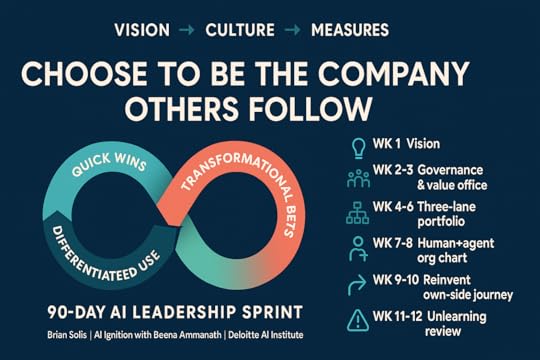
This is your moment to decide whether AI happens to your organization or throughit. The difference is a leader willing to say, “I don’t know what I don’t know,” and then act with conviction to fill in the blanks.
Here’s my challenge to you, wherever you are in the organization, a 90-day sprint to make the future tangible:
Week 1: Leaders, write your one-page motivational future state. Invite input. Name the customer and employee outcomes they will feel in 12–18 months. Share it with your leadership team.
Week 2–3: Stand up an AI Governance & Value Office that pairs risk with product, ops, and finance. Set non-negotiable metrics for adoption, experience, velocity, and revenue impact.
Week 4–6: Launch your three-lane portfolio: 3 quick wins (confidence and capacity), 2 differentiated use cases (what your peers aren’t doing), and 1 transformational bet (what changes your trajectory).
Week 7–8: Audit roles and skills against the vision. Publish a mindful human + agent org chart that empowers and augments your workforce, not automate them out. Fund learning paths tied to recognition and rewards. Document your potential for exponential output not possible otherwise. This is your future moat.
Week 9–10: Reinvent the “own” side of your business with CRM, shifting from a cost-center mindset to an infinite growth center. Pick one critical customer journey and deploy agents to deliver end-to-end personalized experiences and outcomes customers would choose again.
Week 11–12: Hold an Unlearning Review. Retire one legacy KPI, one legacy process, and one legacy belief that no longer serves the vision. Celebrate what you moved from iteration to innovation.
Put dates on a calendar. Name owners. Allocate budget. Report progress to your board monthly. You’ll discover that once the vision is explicit and measured, momentum compounds. Put words to it, articulate learnings and a future-motivating state, and culture follows.
Obviously this is fast, too fast for most to willingly embrace. So what? We don’t need to wait for perfect timelines or clarity to lead. We need the courage to begin, the discipline to measure, and the humility to learn and unlearn along the way…especially in the face of the unknown. I
Define what happens next.
If you take this 90-day challenge, tell me what you learned and what you built, or at least, did differently.. Let’s make this the year we chose transformation over hesitation and formulaic automation, to become the companies others follow.
AIdapt or Die!
Mindshift | Speaking | Newsletter
The post Igniting AI Transformation: How to Future-Proof Your Company in the Age of AI appeared first on Brian Solis.
September 17, 2025
Brian Solis Selected as Featured Speaker at SXSW Sydney 2025
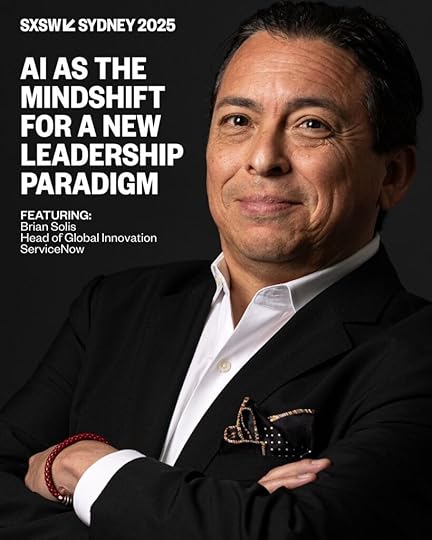
Brian Solis is excited to announce that he’s joining SXSW Sydney 14 October.
His session: “AI as the Mindshift for a New Leadership Paradigm” is open to all who welcome the opportunity to explore how AI unlocks new paths forward.
Please add his session to your agenda.
The post Brian Solis Selected as Featured Speaker at SXSW Sydney 2025 appeared first on Brian Solis.
September 15, 2025
Brian Solis Joins Be Customer Led Podcast to Reimagine Customer Experience in the Age of AI
In this episode, we welcome Brian Solis, Head of Global Innovation at ServiceNow, a nine-time best-selling author, keynote speaker, and digital futurist. Starting the conversation, Brian shares the inspiration behind his latest book, “Mindshift”, and emphasizes the importance of empathy and a truly customer-centric mindset.
Through examples from Amazon, Disney, and IKEA, Brian illustrates how organizations can create meaningful and memorable experiences that drive both loyalty and growth.
The conversation also explores the evolving role of AI, shifting from automation and cost savings to augmenting human interactions and delivering personalization. Finally, Brian calls on leaders to embrace innovation, cultivate empathy, and invest in customer experience as a catalyst for transformation and long-term success!
Listen on Apple Podcasts 
Connect with Brian:
Website: briansolis.com/
LinkedIn: linkedin.com/in/briansolis
Mentioned in the episode:Mindshift: Transform Leadership, Drive Innovation, and Reshape the Future: amazon.com/Mindshift-Embracing-Unlimited-Possibilities-Visionary
Blueprint for Customer Obsession: amazon.com/Blueprint-Customer-Obsession-Marbue-Brown
The post Brian Solis Joins Be Customer Led Podcast to Reimagine Customer Experience in the Age of AI appeared first on Brian Solis.
September 14, 2025
Brian Solis to Deliver AI Lightning Talk at HFS Fall Summit in New York
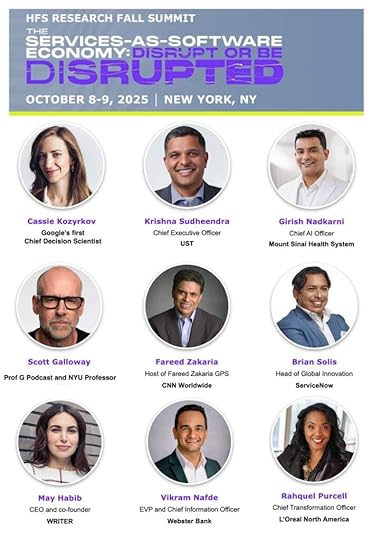
At the HFS Fall Summit 2025, Brian Solis, head of global innovation at ServiceNow, will deliver a lightning talk on harnessing the disruptive power of AI to reimagine business transformation toward exponential performance and outcomes. He believes that it starts with a “mindshift.” In his talk, and the following fireside chat with HFS CEO and Chief Analyst Phil Fersht, Brian will demonstrate the differences between an iterative and optimized mindset and an AI-forward and innovative mindset.
He joins an exciting line-up of thought leaders and practitioners including Scott Galloway, Cassie Kozyrkov, Raquel Purcell, May Habib, Fareed Zakaria, Vikram Nafde, Krishna Sudheendra, Girish Nadkarni, and more!
Who Should AttendBusiness leaders and C-suite executives seeking to understand the future of service delivery and outcome-based business models.
Service providers and consulting firms looking for ways to bridge the divide between human expertise and technology-powered solutions.
Software and SaaS companies aiming to create new revenue streams through partnerships and S-a-S ecosystems.
Attendance is complimentary for a limited number of senior practitioner executives leading services and technology programs in their organizations.
Register here.

Book Brian as a keynote speaker at your next event!
The post Brian Solis to Deliver AI Lightning Talk at HFS Fall Summit in New York appeared first on Brian Solis.
September 12, 2025
ServiceNow’s Brian Solis to Join Panel that Explores Optimizing AI Maturity
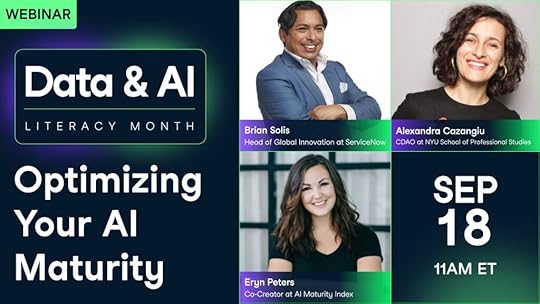
As AI moves from experimentation to enterprise scale, organizations must evolve their talent, technology, and processes to keep pace. Understanding where you are on the AI maturity curve—and how to move forward—is critical to unlocking long-term value and staying competitive in a rapidly shifting landscape.
In this panel interview, Brian Solis, Head of Global Innovation at ServiceNow, Alexandra Cazangiu, CDAO at NYU, and Eryn Peters, Co-Creator at AI Maturity Index, will share how to assess and accelerate AI maturity across your organization. You’ll learn how to build an actionable roadmap, align strategy with capability, and lead a successful AI transformation. This session is ideal for executives and managers seeking to elevate their organization’s AI impact.
Register here.
The post ServiceNow’s Brian Solis to Join Panel that Explores Optimizing AI Maturity appeared first on Brian Solis.
September 11, 2025
Brian Solis Named Top AI Leader in Retail for 2026 by Rethink Industries
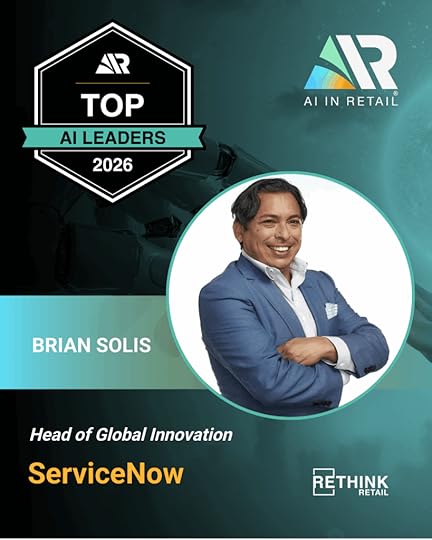
Brian Solis is proud to be named one of Retail’s Top AI Leaders for 2026. Please see the full list here.
The post appeared first on Brian Solis.
September 10, 2025
Brian Solis: Bring Your Own AI (BYOAI) and the rise of shadow AI in the workplace

Brian Solis was recognized for his use of the term “Bring your own AI” or “BYOAI” in an article by Neil C. Hughes writing for Cybernews.
BYOD, also known as “Bring Your Own Devices,” was a trend that IT infamously failed to prevent as leadership teams and workers united in their demands to bring their personal iPads and smartphones into the office. While IT teams attempt to rebrand themselves as business enablers rather than blockers, many workers are once again regaining control. This phenomenon is being dubbed “Bring Your Own AI,” or BYOAI, and it’s spreading through offices worldwide.
Welcome to the new shadow workforce of AI-powered employees hiding in plain sight. Behind every minimized window is a user hiding AI tools to get ahead, while company policies struggle to catch up.
Users who have their own AI accounts and use it at work, eclipse the number of companies providing AI to employees. While @mit calls this the "Shadow AI Economy," I call it BYOAI. Just like in the early days of iPads and iPhones, IT adapted to support BYOD (Bring Your Own… pic.twitter.com/3E55MWhJgh
— Brian Solis (@briansolis) August 23, 2025
The post Brian Solis: Bring Your Own AI (BYOAI) and the rise of shadow AI in the workplace appeared first on Brian Solis.

